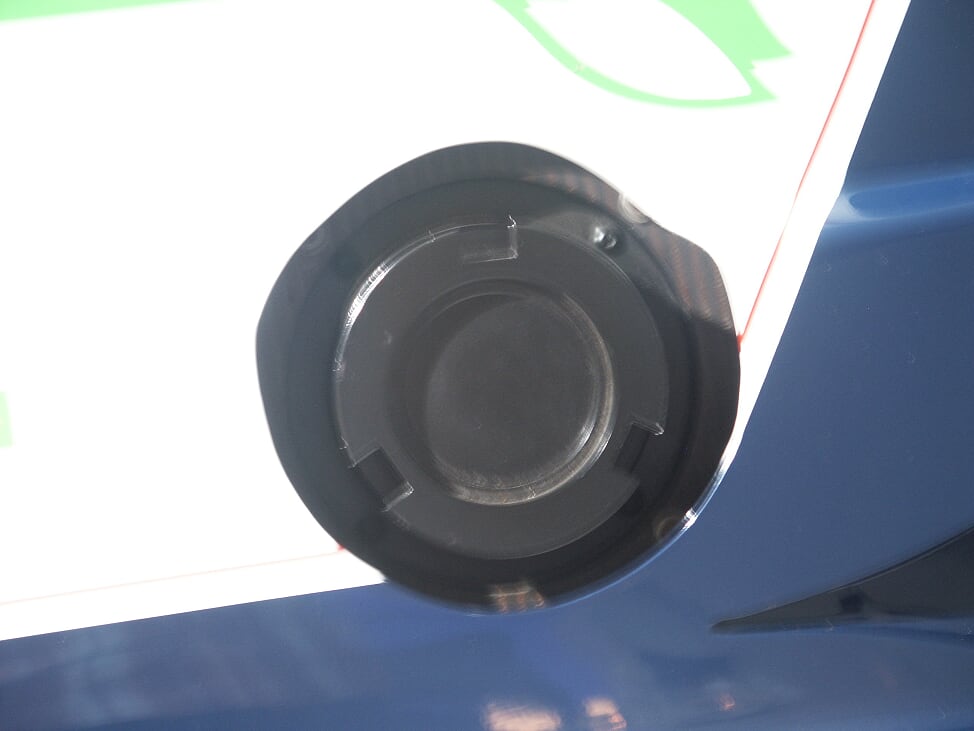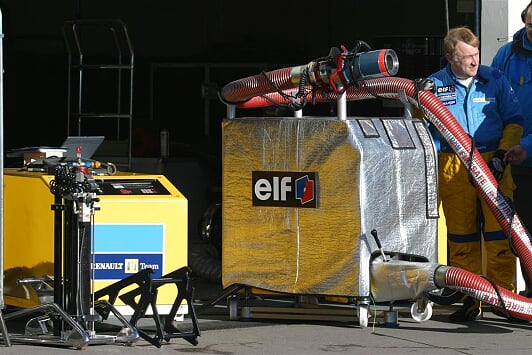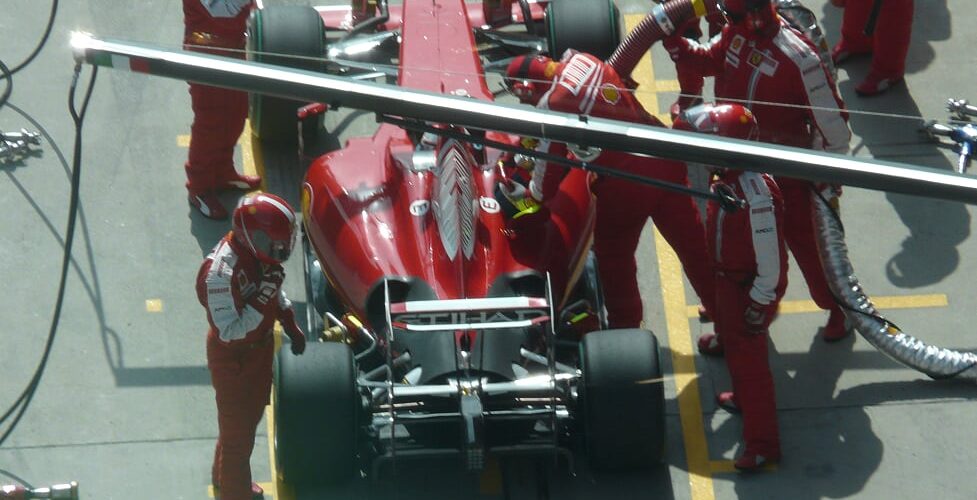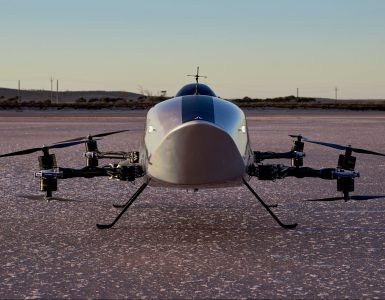During the build-up to the German Grand Prix weekend, it was coincidental that FIA president Jean Todt suggested F1 could make a return to refuelling in order to spice up the show!
Of course, the frequent changes in weather conditions, with teams gambling on strategy between full wet, intermediate and slick tyres made for one of the most dramatic races in recent memory. So is such a move really necessary?
It was at the German GP in 1982 that a team first tried to make a planned stop for fuel and tyres mid race, and some 12 years later, it was Max Verstappen’s father, Jos, who was famously doused in fuel from the pump and ignited a fiery blaze. Refuelling has a chequered history in F1, and the suggestion that its reintroduction to F1 would improve the racing is based on a sound premise, but in practice its effect could be negligible.
Modern F1’s first refuelling era

Refuelling has been in F1 since the early days, with ad hoc topping up of fuel during pit stops, but the idea of strategic refuelling in the modern era was first introduced by the Brabham team in 1982.
Gordon Murray, the team’s technical director, recognised that the car had a high starting weight, due to the huge amount of fuel the turbocharged engines of the time consumed. Reckoning that a ten second pitstop would cost less time than the lighter fuel load and softer compound tyres gained, the idea for a mid-race stop would result in a quicker overall race time.
The Brabham team and its BT50-BMW turbo accordingly arrived at Hockenheim drilled for pitstops, with the car modified for the pitstop, refuelling kit and the crew dressed in fireproof overalls. Revisions to the car went further than simply a refuelling nozzle exposed on through the bodywork on the side of the fuel tank. Murray went as a far as fitting integral quick lift jacks and the requisite airline connector to operate them. As mid race pitstops were required back then for emergencies, the team already had air guns and single wheelnut axles.
The refuelling kit was bespoke for the team, although refuelling was common in endurance racing, for safety in that category, the fuel delivery was gravity fed. For a rapid F1 stop, gravity alone would not do, so the team resorted to a pressurised system, where the fuel was kept in its storage tank under pressure and would empty quicker when connected to the refuelling nozzle. The other aspect to refuelling rapidly is a means to vent the fuel tank. You could put 100 litres of fuel into the tank in seconds, but the air in the tank will need to go somewhere, so a vent bottle is also connected to the tank, to allow the air to escape. This creates two major issues, firstly the air in the tank is saturated with fuel vapour, making it highly flammable. Secondly, the vent tank needs to be connected to the tank before and removed after the refuelling nozzle. If this procedure isn’t followed, the fuel tank could burst under the pressure or, more likely, there could be blow back of air/vapour through the fuel nozzle/vent nozzle. This latter risk sends high pressure fuel vapour back out of the tank into the atmosphere and such an escape would inevitably lead to a fire.
Brabham’s first attempt to make a pitstop at Hockenheim was famously denied by a crash between Nelson Piquet and the backmarker ATS driver Eliseo Salazar, leading to a fist fight! Other attempts were thwarted by the unreliable turbo engine, often failing before the mid race point when the pitstop was scheduled. It wasn’t until the Austrian GP that the pitstop actually took place, albeit without taking the win, indeed even with this tactic Brabham never won a race in the final races of 1982.

At this point, Gordon Murray could see that having the mid race pitstop was a huge potential strategic advantage, so much so that the car intended for 1983 was a development of the successful Brabham BMW BT50 was that its main update would be to make a pit stop only car, by reducing the size of the fuel tank. It transpired that a late rule change meant the BT51 would never race, but its hastily designed successor, the BT52, would also be a pits top car and win the drivers’ world championship in 1983.
As the other F1 teams prepared for 1983, they could also see that the potential for pitstops was beneficial. As the season started in Brazil, several teams had also readied refuelling equipment. Although Piquet won for the first time with a pitstop in the Brabham, already any benefit Brabham had was being eroded as these teams joined the pitstop bandwagon. Almost immediately, the risks of refuelling were made apparent. The Williams team, then racing without a turbo engine, chose the pitstop route. At Rosberg’s race stop, there was a flash fire. The Finn jumped from the car and the flames were extinguished. Rosberg and his car were able re-join the race, but the risks of high pressure refuelling were on show. The sight of flames at a grand prix, when just the year before Ricardo Paletti died from the fire that ensued after a start line crash, should have brought refuelling to an immediate halt. But it didn’t.
This unregulated form of pitstops continued, with teams setting their own standards for speed and safety. Fortunately, there never was the huge conflagration, but equally the goal of faster race times to give Brabham the advantage was gone. With everybody deciding their own start fuel load and pitstop fuel top up, there was little to differentiate the team’s strategy. The practice was soon banned at the end of the season.
Modern F1’s second refuelling era

Formula1 is often cyclical, and in 1994 refuelling was reintroduced, but this time with a FIA regulations setting speed and safety standards. Key to the new pitstop regime was a specification refuelling rig, supplied by Intertecnique. These large, heavy, and expensive rigs would be brought to every race, one per driver, at huge cost. But their design was aimed at reducing the free for all that existed under the previous pitstop era.
The Intertecnique rig housed the fuel and measured it as it was pumped under light pressure to the car. Aside from the reduced delivery pressure, it was the delivery mechanism that was the key safety gain. A single refuelling nozzle, when mated to the car, only delivered fuel when the locking mechanism engaged, and the mechanic pushed the handle down. In doing so, this connected not just the fuel line, but also the vent pipe simultaneously, reducing the potential error of not connecting the vent tank before the high-pressure fuel entered the tank.

This delivery nozzle was heavy, so that when the delivery pipe was fuel of fuel it took two strong mechanics to support the hose and guide it into place accurately at the stop. Any misalignment would prevent the locking mechanism from engaging and no fuel would be delivered until it was removed and reattached. Many a pitstop was thwarted by the nozzle not connecting. Equally, the rigs were not 100% reliable and often teams having to switch rigs between cars if one driver’s fuel rig had an issue.
While this unreliability introduced a degree of jeopardy into the refuelling event, the fixed flow rate offset this so no team could have an advantage at the stops because the total race fuel required for a driver’s race was effectively the net of the start fuel load and the pitstop fuel loads. If you start the race light on fuel, the stop would have to be longer. Pit stop times were also long, typically around ten seconds (the tyre change was far quicker than that), so the pitstop time was effectively your refuelling “nozzle time” plus the tenths it took to engage and disengage the refuelling nozzle. This greatly reduced most tricks to gain an advantage, and other teams would watch through binoculars and time rival’s nozzle time, in order to calculate their window to the next stop.
Pitstops under this regime became a strategic means to gain places over the car ahead. Not from on track overtakes, but through the pitstop window. Often the radio message to a following driver was, “wait for the stops, we’ll pass them there” as saving fuel behind the slower car, the driver could have a shorter pitstop as they required less nozzle time. Or, in a race with more than one stop, the driver could be short filled in the first stop gain track advantage and have to take on more fuel at a longer second stop.
Still, the fire risk existed with the standardised rigs, an iconic image of the risks in F1 was the Verstappen pitstop fire, again coincidentally at Hockenheim in 1994. At other races, drivers departed the pit with the fuel rig still attached and full of fuel. The competitive drive of the teams to gain tenths at a pitstop invited errors and lead to risks being taken and accidents happening.
Finally, the practice was again stopped in 2010 and F1 kept to races being run with the car’s race start fuel load.
Jos Verstappen's Benetton dramatically catching fire during during a pit stop at the 1994 German GP – Hockenheim. #F1 pic.twitter.com/vJyKPelBiE
— F1 Images (@F1_Images) August 10, 2017
A third refuelling era?
Now, with F1 questioning itself on how much of a show it puts on for fans, the FIA president has suggested reintroducing fuel stops. This isn’t the first time the reintroduction has been mooted, but every time previously it was quickly and soundly rebuked for many good reasons.
Todt’s suggestion is that refuelling gives an extra variable into race strategy, this meaning the cars can run lighter and thus faster for more of the race, as well as play with fuel loads at pitstops to vary their pace through each stint. This variability should therefore produce races with ‘overtakes’ from the difference in pace and strategy between the teams. This is quite a sound theory, but past experience suggests it’s not as simple as that.
First of all, let’s put aside the other factors refuelling entails. Firstly, the cost. When F1 is trying to cut operating costs for the teams, buying and shipping refuelling rigs, plus all the teams related paraphernalia around the world will be expensive.
As with the spec Intertecnique rig, the safety issue can be managed to a degree, but the risk of a fire from pitstop errors remains as do potential crashes into refuelling hardware the pitlane. Teams already run start light systems in the pits for tyre changes, to prevent the driver leaving without car being ready. Similar methods to warn the lollipop man of refuelling rig still being attached can be employed. But, as with the tyre stop lights, failures can still occur.
There’s still a question mark over what image F1 should portray. Since 2009, with energy recovery systems and latterly fuel flow and capacity restrictions, the sport has sought to portray itself as greener and less wasteful of fuel. This image is not universally liked by the fans, but as yet the sport has yet to openly define what direction it wants to go with its ‘green’ image. Regardless, the reintroduction of fuel stops will only serve to highlight the high consumption of fossil fuels. As with cigarettes, alcohol and pitlane girls, does F1 see it as socially acceptable to be viewed this way regarding fuel?
As well as image, refuelling is a spectacle which the sport revels in. Its undeniable that the refuelling era did bring a moment of jeopardy and excitement as each driver made a stop. This could be seen as a welcome interlude for fans during the race, but we already have pit stops for tyres, at least as exciting as refuelling. One issue with the latter refuelling era was that the fixed flow from the fuel rigs meant that pitstop times were dictated by nozzle time, the car going up on jacks and tyre changes didn’t greatly affect the pitstop time. So, a quick pitstop wasn’t a human achievement, merely a short fuelled stop. Even so, misguided commentators would applaud a super quick time, but it was rarely in the hands of the pit crew – rather the refuelling rig and race strategy. Currently, we have sub 2s tyre stops. With refuelling, we might have 10s stops, so the spectacle and human achievement is better served with just tyre stops
In terms of the technical effect of refuelling, the cars will have smaller fuel tanks, and this has several effects. The car will be slightly lighter at all times, due to the slimmer monocoque, possible from a smaller volume fuel tank, but will require the weight of the heavier refuelling nozzle, so the net effect will only be a few kilogrammes of savings. While at their lightest in qualifying, the cars will start the race much lighter without the 110kg fuel load. With a two-stop race, as little as 36kg might be in the tank, saving over 74kg. Thus, in race trim, the cars will be much faster.
Having a smaller fuel tank allows other performance benefits. It’s unlikely the length of the cars will change, the long wheelbase fashion is for aero reasons, not the inability to package everything into the space. More than likely, the teams will either narrow the fuel tank to allow for slimmer sidepods, or shorten the tank and lengthen the gearbox accordingly to narrow the coke bottle area. This aero gain will also speed up the cars.
If we have lighter, faster cars, then the other question revolves around tactics in the race, will it lead to overtaking? Will that be on the track or in pitstops?
First, we need to make some assumptions on qualifying and race fuel loads. With qualifying completed on minimum fuel and the car’s race start fuel load free for the team to decide, there is a risk that all the teams will optimise the strategies and leave little scope for in race tactics. If, like with tyres currently, the top ten have to start with tyres and fuel left over from qualifying, then the bottom ten are free to select their tyres and fuel loads. Then we might see some variability in the race strategies, with different cars on track at different fuel loads, overtaking may be improved on track.
Things also depend on tyres and fuel flow rate. Will there mainly be one stop races or will there be a crossover where multiple stops are as fast? If everyone is fixed into a one stop strategy, then there’s much less scope for variability in strategy and thus on track action. F1 will need to factor in the tyre when considering any reintroduction to refuelling.
A typical race situation is a driver stuck behind another slightly slower car, with the delta in laptimes and DRS unable to allow an on track overtake. Then, currently, it’s the tyre stops that are used tactically. There’s the undercut or overcut. With an undercut, the following car stops early and with fresher tyres can lap faster to gain track position by jumping the car ahead. With refuelling, the following car will be heavier after the pitstop and thus slower, so the undercut will not always work, which is a major setback to race strategy. The following car could refuel a little less, thus gaining track position, but that may be lost with a slower second stop. Equally, the leading car seeing the short-fuelled undercut being attempted could also short fuel, negating the following cars advantage.
With an overcut today, the following car stays out longer if it has the tyre life to lap faster than the leading car on fresh tyres. With refuelling, this would be the preferred tactic if there is the fuel in the tank. The following car can save fuel ahead of the pit stop, run longer knowing the nozzle time for the leading car, then pit with a nozzle time adapted to beat the car that was ahead. This is a near slam dunk strategy, but not one that would lead to on track overtaking.
Conclusion
It’s clear to see that refuelling does present some potential formats to allow overtaking if either the field are split on strategy or there are multiple pit stop strategies, likely to be as fast as each other. But refuelling takes away the undercut option, invites overtaking to be delayed until a pit window and still has the image, fire risk and cost issues.
Given the huge progress made with the technical regulations regarding the aerodynamics of overtaking, there’s a strong argument that we leave it to the faster car and driver to overtake and not introduce another artificial variable in the rules.
F1 Pit Stop Fire Accident – 1994 German GP, Jos Verstappen. pic.twitter.com/u0gCNk1TVA
— Sport & Betting History (@CDCHistory) March 25, 2018




